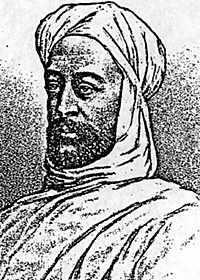 Science vs Pluck is a set of miniatures rules for playing
games set in the Sudan campaigns of 1881 to 1899. They are an
interesting blend of the unique while growing out of the long
tradition of miniatures wargames. Most of this issue of EGG is
dedicated to giving these rules a through going over.
Science vs Pluck is a set of miniatures rules for playing
games set in the Sudan campaigns of 1881 to 1899. They are an
interesting blend of the unique while growing out of the long
tradition of miniatures wargames. Most of this issue of EGG is
dedicated to giving these rules a through going over.
SvP is a set of miniatures rules. It is also a method for roleplaying historical events. The games are exercises In problem solving and cooperation. A story is told by the players and a referee. Hopefully it is a story of excitement and daring. While at the same time the tensions of the game parallel the tensions of the historical players so as to create a "recognizable pattern" that can be called "realistic."
How does Howard Whitehouse do this?
THE RULES
SvP comes complete with two rules books (one for the players and the other for the referee) and a handy quick reference sheet. The actual rules mechanics of the game are included in the referee's book. The players book gives only the briefest outline of how the rules work, to intentionally keep the players in the dark. This section deals with the referee's book. What are the rules? What does it seem like the book is saying to do?
The umpire's book is approximately 40 pages in length. My method of analysis will be to look at each section in turn and say what I think it is saying the procedure is. Some charts will be shown and ambiguities pointed out.
The table of contents reads as follows...
1. Introduction
2. The Art of Umpiring
3. Character Briefings
4. The Forces
5. Sequence of events
6. Intentions; Time allowed
7. Dervish movement
8. Imperial movement
9. Dervish Fire
10. Imperial Fire
11. Firing at Fortifications
12. Officer Casualties
13. Dervish Reaction and Second Move
14. Imperial Reaction
15. Melee
16. Disorder
17. Rallies
18. Emergency Responses
19. Duties of Officers
20. Visibility
21. Ending the game
22. Unexpected Difficulties
23. Free Kriegsspeil
INTRODUCTION
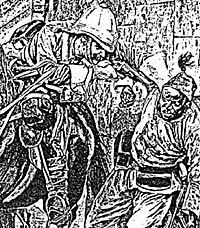 Howard Introduces SvP with two period quotations. These,
and his following text say that this is a game about facing savages
with true Victorian style. There Is an emphasis on ACTING and
ROLEPLAYING. He seems to be saying that it is more important how
the players play the game than whither they win or lose.
Howard Introduces SvP with two period quotations. These,
and his following text say that this is a game about facing savages
with true Victorian style. There Is an emphasis on ACTING and
ROLEPLAYING. He seems to be saying that it is more important how
the players play the game than whither they win or lose.
Most importantly for the referee is thefollowing. "There are few strict rules to 'Science vs Pluck;' this is an informal game based on conforming to a given character and to a Victorian ideal rather than a rigid set of instructions." This seems like a clear 'Invitation to alter any of the rules that follow to suit the referee's needs of the moment. An interesting way to, start off a rule book!
THE ART OF UMPIRING
This brief section begins with a recommendation that the referee make a scenario challenging and interesting. This is followed by examples of some of the fighting characteristics of the Mahdists. The Dervishes are run, in part, by a "semiautomatic" system (to be described later) which roughly follow a basic battle plan decided on by the referee at the start of the game. Mainly though the referee is encouraged to be creative and unpredictable. All in all this seems to be a hard order to follow. But since this is a matter of such importance to SvP that it will be looked at more fully later.
CHARACTER BRIEFINGS
Each command personality in the game, and a few non command people like Syrian Interpreters and Ethiopian Guides, have a short briefing that describes the individual's personality. The briefing seems to be geared to educating the player in how to role play this person. Unlike most RPGs that use statistics, SvP uses words. Phrases like "You have long discovered that direct solutions tend to succeed where complex plans do not." axe used rather than "You are not too bright." The briefings also include Impresions that characters have of the other commanders.
Again the emphasis seems to be on role playing, and as before it seems vague as to how exactly a referee is to do this.
THE FORCES
This section first describes what factors are used to describe the units In the game. The mechanics seem to focus on the quality of a units drill (good, fair, or poor) and whither they are Hot or Cool blooded. This effects a units morale reaction which is described later.
The scale of the game is on a large scale. 1" equals fifty yards. one stand of Infantry equals a company of soldiers (some 75 to 125 men), which has a frontage of some thirty to 40 yards. The number of figures on a stand is irrelevant. This scale seems to be set for 6mm figures though there seems to be no reason why it won't work for larger figures just as well.
SEQUENCE OF EVENTS
The sequence of play is as follows...
1. Intentions: ie what does the player plan to do next?
2. Time allowance: The referee decides how long the next
turn will be.
3. First Dervish move.
4. Imperial move.
5. Dervish fires.
6. Imperial fire.
7. Dervish reaction and second move.
8. Melee and post-melee movement.
9. Rallies.
The players may seek to interrupt this order of play at any time by trying to do an "Emergency response." More on this later.
The remainder of the rules seem to walk the referee through the sequence of play and explain each in turn. This seems to be a clear understandable way to explain rules but it does tends to require the reader to read the whole book to know how the game works. Reading only one section would seem more likely to confuse a new referee rather than educate him. Unfortunately I don't know a better way to do teach new rules than this. [maybe this would be a good future article]
INTENTIONS
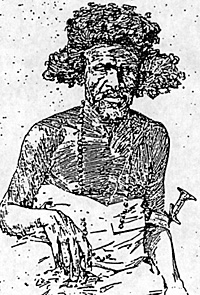 Miniatures games tend to require the players to write orders
for their units. These ordersare then acted on by the units in
the next turn. Each turn lastfor a set length of time so orders
may take many turns to complete. SvP handle orders in a slightly
different way.
Miniatures games tend to require the players to write orders
for their units. These ordersare then acted on by the units in
the next turn. Each turn lastfor a set length of time so orders
may take many turns to complete. SvP handle orders in a slightly
different way.
Each turn the referee asks the players what their "intentions" are for their men. Not intentions for this turn, but what they want their men to do next. So players are not ask to maximize their gains for this turn. They are instead asked to think like a commander who must set his own agenda.
This seems to be a vital point in each turn and for the game. But the section that describes it is shorter than this section of this article. For a player to play SvP well, he must give good orders to his men. To do this via intentions would seem to require players to give up the normal game strategy of maximizing each turn and think about battle in a new way.
TIME ALLOWED
"In most wargames a turn represents a 'set' period of time, perhaps 2, or 5, or 15 minlutes. This is not the case in 'SvP' ... Instead we have a flexible time scale." without using the word, SvP seems to use a "variable length bound." which of course means that the length of the turn can and will vary depending on what is happening. The length of the turn is decided by the referee who supposedly bases this decision of the "criticalness" of the events that are about to take place.
If a player decides to "brew tea and water the camels" then the turn may last as much as six hours. While if a players Intention is to "shoot the beggars before they hit the square!" the turn may only last a minute or two. Howard makes one suggestion to new referees on how to make such rulings. It is generally better to err on the side to shorter bounds than longer ones, since in five minutes a unit can be over run while in one minute increments they may stop before walking into a trap.
DERVISH MOVEMENT
This section starts by saying that Dervish movement is determined by the result from a Dervish Reaction test. This test apparently determines if the Mahdist start moving at all as well as if they begin to speed up or slow down. It is not explained how this works. This seem likely to disconcert a new referee, since it seems important but is deliberately kept a secret. Is it a hard mechanic to manage? This could stop a new referee cold, by planting the seeds of doubt.
In fact though movement seems to be quite easy. Units may move at a walk, a trot, or Charge. Movement rates are given In yards per minute for each speed. Consequently if a unit is moving at a walk (100 yards per minute) for a ten minute turn, then the unit would move 1000 yards or 20 inches. While moving over rough ground a roll is made to see if the original speed of movement is modifled by rocks being in the way.
Depending on how fast a Dervish unit is moving, more or less of the stands of the unit will enter into melee. Charging units seem to move all their stands into the action (momentum apparently carries them through). Trotting formations seem to roll a D10 for every ten stands in the formation, to see how many of the ten actually make contact. Walking formations stop in the face of the enemy and wait to be annihilated by rifle fire.
IMPERIAL MOVEMENT
Imperial movement seems to be done in the same way that Dervish movement is save that the player decide how far and at what speed they want to move in.
The reaction table itself includes such catagories as 1. Close order-within 700 yards of the enemy, and 2. Skirmishers. In soft cover. Prone. Both of which seem to be statuses a unit might find Itself in. But they seem a little confusing. Does close order refer to the Imperial troops or the Dervishes? My guess would be It means the Imperial since Mahdist tended to have only one battle formation - the mob. That might mean that "Skirmishers" refers to Imperial scouts, while "In soft cover" and "Prone" refer to the Dervish unit. This is not clearly spelled out, but with a little figuring it does make since.
All in all Dervish reaction seems quite simple to run. Also since the players are unaware of how the Dervish rolls are going, it would be an easy Job for the referee to add modifications of his own to ensure the the Mahdists do not run away too soon.
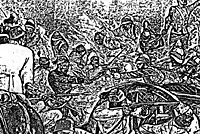 IMPERIAL REACTION
IMPERIAL REACTION
Another word for reaction could be morale check. That seems to be what the Imperial reaction test is all about.
Unlike the Dervishes, Imperial troops are controlled by the players. They will do what ever the player says until their reaction status prevents them from obeying. Troops can go through the following "reaction stages."
- 1. Calm - will follow orders with no problem
2. Excited - will fire as fast as possible or go Into melee with the nearest enemy
3. Nervous - will not move forward and fight/fire poorly
4. Panicked - will flee in terror
This sounds rather straight forward. As "morale" drops, the player has his troops actions dictated to him by the roll of the dice. This is only likely to be critical when the Dervishes are only 100 yards out, but then that is when morale checks are usually made!
Reaction checks are made when ...
- 1. A unit loses a stand due to fire (very unlikely) or
melee (much more likely).
2. A unit has two or more disorder markers at the same time.
3. A unit wishes to charge the enemy.
4. The first time the enemy comes within 300 yards of a unit.
5. or whenever the referee decides that something has happened on the battle field that should cause a morale check.
Reaction checks seem to be made by rolling one d6, modifying the result by a few tactical factors, and comparing it to a table. The table is rather interesting. It is divided into two columns, one for "cold blooded" troops (like most British regulars - cold blooded meaning calm under fire, not viscious killers) and one for "hot blooded" troops (like most cavalrymen). The table Is divided into three different parts that correspond with the stages of reaction (calm, excited and nervous, panicked being left out since it would seem that once there one's morale can go no lower!). The reaction die roll, when compared to the chart informs the player whether his men maintained their morale status or if the unit progresses to a less controlled status.
The only complicating factor for Imperial fire power is that the men only carry 10 minutes worth of bullets on their person (which as all Zulu fans know, is a good way to be wiped out if it is squandered of long range shots). Hit rolls seem to be made for every minutes worth of fire. So if one stand fires two minutes worth of ammo in a ten minute turn, then the player would roll two dice for hits. It seems to be left up to the player how many minutes of fire to use in any given turn, though naturally it pays to conserve.
Fire over all seem fairly simple. It involves rolling lots of dice to check hits. Then rolling again to see if the hits do anything. Along the way the player must keep track of. the ammunition expended. This definitely gives a Zulu war feel to it.
DERVISH REACTION AND SECOND MOVE
At last!
The Dervishes start off the game with a basic plan of action, provided by the referee, but once the game begins most of the Dervish moves seem to be determined by the results of reaction tests.
Reaction tests are made ...
- 1. Whenever a Mahdist unit is shot, or
2. Whenever the referee thinks there is a reason/event that might cause an emir to change his plan.
The test seems to be done by rolling 2d6 and modifying the result based on casualties, and a few other tactical factors. This number is cross referenced on a table of several possible situations the Dervish unit might be in. This yields another number ranging from +4 to -4. It seems that this number determines the change in a units activity.
Dervish activity seems to be based on a scale (see below). As reaction tests are made, a modifier from +4 to -4 Is found. The modifier 15 added or subtracted from the scale.
- 1. Flee the field.
2. Rout beyond harm's way
3. Retreat at a walk.
4. Pinned (may not fire) or disperse into isolated small groups.
5. Prone (may fire) or move at a trot to the left or right to threaten flanks.
6. Stand still.
7. Advance at a walk, may maneouvre.
8. Advance at a trot, may maneouvre.
9. Charge straight ahead!
So it would seem that if a Dervish armies plan was to lay Prone until the enemy got close enough to charge, their beginning status would be five. If scouts came up on top of them a reaction test would probably need to be made.
Say the result was a +2. This would seem to mean that the unit would get up and start advancing at a walk. Not necessarily a good plan.
When Imperials move over rough terrain they roll to see if their speed is modified just like the Dervishes do. But they also seem to run the risk of obtaining "disorder" markers. These are not explained yet but unlike "Dervish reaction tests" they seem unlikely to "spook" a new referee, since they are understood to be "bad."
Formation changes seem to be handled by looking at how long it would take for all the stands to reach their position in the line at a march speed. So if a unit is close to the enemy and tries to change formation it is likely the the length of the turn will not be long enough for all the stands to be in place in time.
DERVISH FIRE
Dervish fire seems to be handled by rolling 1d6 for every stand that Is firing. Depending on the firers range from the unit It is easier or harder to hit. For instance Point blank range Is only 100 yards with hits being scored on a roll of 3 or more. Long range for modern rifles is out to 1400 yards with hits only happening on a roll of 6. once the number of hits is determined the player rolls 2d6 on another table to see what the result of the fire was. The result table for Dervish fire seems geared to make Dervish fire pretty ineffective. The main result to be gained from this kind of fire is to place "Disorder makers" on enemy stands.
IMPERIAL FIRE
Imperial fire seems to be handled by the same process that Dervish. fire is except that the final table is different. The Imperial fire table can cause the Dervishes to make a "Reaction test" or more often it kills stands. All in all the Imperial fire table seems to be geared to make British fire instant death.
Like Dervish reaction, Imperial reaction seems straight forward once looked at. The most important modifier or morale seems to be the presence of disorder markers. The marker only seems to effect that one stand so it is possible to imagine their being several different reaction results happening in the same unit due to one roll. This is a unique possibility that makes a lot of sense "realistically." It is all the more interesting since this kind of diversity of reaction is created through a quite simple rules mechanism.
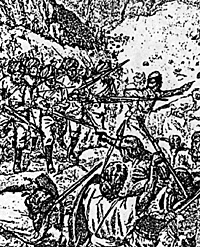 One point that is not made clear in this section is
whether it is the individual stand or the whole unit checking
reaction. By the end of the section it seems obvious that
reaction is checked by whole units. But would that be the case if
the critical stand was in a detached unit half the battle field
away? My guess would be that it would not effect the stands not
present but this could be a problem for those players looking for
any rules loopholes.
One point that is not made clear in this section is
whether it is the individual stand or the whole unit checking
reaction. By the end of the section it seems obvious that
reaction is checked by whole units. But would that be the case if
the critical stand was in a detached unit half the battle field
away? My guess would be that it would not effect the stands not
present but this could be a problem for those players looking for
any rules loopholes.
MELEE
The heart of all colonial wargaming is the point when the enemy swarm out of the earth from every direction and run screaming at the Imperial line. Howard's melee proceedures are divided into four parts, 1. defensive fire, 2. melee, 3. breakthrough, and 4. a melee result (post melee morale check).
- 1. Defensive fire: it seems that units are allowed to
make an extra minute of fire on the charging horde as it closes
into point blank range. Fire is done normally except that if a
firing stand rolls a six on the to hit roll, that stand is
assumed to have put out such a deadly volume of fire that not
Dervish unit will attack it. instead the cowardly devils divert
to less fierce looking stands to either side.
- for each enemy stand killed in melee 2 points
- for each enemy stand killed in defensive fire 1 point
- for each enemy stand driven off in disorder 1 point
- for each breakthrough achieved 1 point
2. Melee: SvP melee seems to be a lot like "The Sword and the Flame" melee. Stands pair off and roll six side dice against one another with some tactical modifiers. If one side scores two point higher than his opponent then the loser is thrown back in, disorder. Scoring three or more greater than the opponent means that the loser is eliminated.
The dice rolling part of melee seems simple enough, but the tactical modifiers of these rolls are put into a table that is a little confusing to read. Depending on what types of units are' facing off then the modifier is different. The table in question has rows which describe the type of attacking unit (from Native spear to Imperial foot). This is cross reference with columns that describe the type of defending troops. Cross referencing gives a number that ranges from +3 to -3. This is the tactical modifier.
What is not made clear is which side this modifier is to be applied to. it seems as though it-applies only to the attacker since the modifiers for skirmishers attacking formed troops gives a negative modifier (so t9 discourage such silly attacks). But' when I first looked at the table, I immediately thought that both sides would get a modifier. With this kind of initial assumption settling melee becomes much more difficult.
The melee modifier-table is only used by the referee? So it is not necessary for players to be exposed to this table.
3. Breakthrough: It seems that when a Dervish unit eliminates its opponent that it immediately charges forward into the nearest unit and fights another melee. The stand is now Immune to future reaction rolls and will stay in the melee until it is destroyed.
4. Melee results: This appears to be a process to add up the "score" after each round of melee to see who is winning. This score is them translated into what is in effect a post melee morale check.
Each side scores for doing the following ...
The melee result depends on how much a sides score out numbers the enemies score. It can range from The Imperials scoring three times greater than the Dervishes a "Glorious victory." To the Dervishes scoring three times greater - a "Disaster." What ever the result each side is given a modifier to use when rolling on a "Melee result table."
The rules state that one d6 is rolled for each side and modified according to melee result decided above. Suffice it to say that if a side has scored a "Disaster" they are not likely to gain a good result from this test.
Adding up a post melee victory result, as is done in SvP, is not something that happens in a lot of Colonial miniatures games. Consequently this could be a little bit confusing to a new referee who is used to other colonial rules.
DISORDER
Disorder seems to be the tactical factor that the players can have some control over, that effects melee. Units become disordered when they...
- 1. Get disorder results from being fired
on.
2. Pass over rough ground.
3. Have a friendly unit rout through them.
4. And when a unit completes a melee.
Disorder seems to be measured by "Disorder markers." A unit can build these up throughout the game. They act as negative modifiers in melee, so it behooves the player to keep his troops in good order and stop and rally them when needed.
RALLIES
In the last phase of the turn a player can chose to rally a unit with a disorder marker on it. But watch out! It is possible to rally your men right into a panic, or as Howard puts it "PANIC! Well done, Sir!"
EMERGENCY RESPONSES
This is a rules mechanism that allows the players to circumvent the regular order of play to attempt to do something special. The player does this at the risk of confusing his men and exposing his command to disaster!
When ever a player wants his men to do something outside of the regular order of play, he tells the referee what he wants to do and the referee decides if he wants to allow him to try it. Howard suggest permitting the following actions ...
- 1. Withdrawing units about to be overrun.
2. Charging In men to prevent a breakthrough.
3. Firing one minute out of phase.
4. Withdrawing from melee by choice rather than by losing.
5. Or what ever the player comes up with.
If the player is allowed to try the action then he rolls one d6 on a table. The more time a unit has to react, the more- likely it is that the response will happen. If the player rolls poorly then his unit can fall to do the action, gain disorder markers and possibly drop a reaction stage.
This is an interesting rule that give the rash player the means to create a disaster out of victory. After doing one of these emergency responses one appreciates better why military men tend to be conservative. It doesn't pay to innovate when the enemy are at your doorstep.
DUTIES OF OFFICERS
This brief section spells out what actions a player commander is allowed to do, and is self-explanatory.
The most important part seems to be at the end. "In addition, characters are at all times expected to conduct themselves like gentlemen."
VISIBILITY AND CONCEALMENT This section includes a chart that gives distances enemy units in various type of cover, might be seen at. The basic message this chart gives is that they can see you but you can't see them until you are on top of them or they come out in the open.
ENDING THE GAME
Howard points out that it is important for a game of SvP to not end just when the Dervishes flee from the field after a failed charge. The game often goes on until the players have reached their original objective. Who knows, there may be another ambush just over the next hill.
SvP does not seem to be a game of clear winning or losing. The British are often in control of the field at the end of the game. But if they lost too many men, or if the camel were not watered in time, and protested by dying, then victory might be meaningless.
AFTERWORD
These then are the rules of SVP. They are fairly straight forward. But to run a game Just by reading the rules might be a little difficult. There seems to be more to this game than just the rules. Those extra thing deserve articles of their own.
Back to Experimental Games Group # 14 Table of Contents
Back to Experimental Games Group List of Issues
Back to MagWeb Master Magazine List
© Copyright 1991 by Chris Engle
This article appears in MagWeb (Magazine Web) on the Internet World Wide Web.
Other articles from military history and related magazines are available at http://www.magweb.com